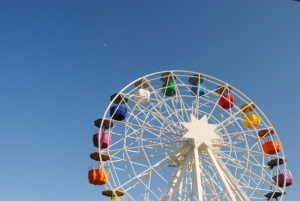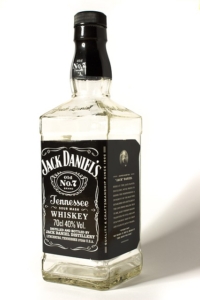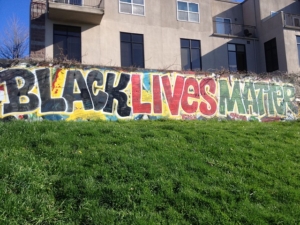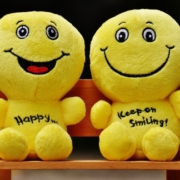What’s Your Emotional Brand?
I’m reading The Dream Society, the 1999 futurist essay by Rolf Jensen of the Copenhagen Institute of Futures Studies. It bears the subtitle “How the Coming Shift from Information to Imagination Will Transform Your Business,” and it’s magical in one of those “this guy has put into words almost everything that I’ve been observing about the times in which we live” kind of ways.
In the space of little more than 200 pages, Jensen has captured the storytelling zeitgeist that our world is in the process of embracing. He’s also provided some insights about millennial audiences that I’ve found to be a wonderful resource as a copywriter and blogger.
Table of Contents
Farewell, Information Society
Jensen observes that the twentieth century was characterized by the emergence of the Information Society, in which “knowledge becomes more important than capital,” and in which “numbers are better than words because they are concrete; they reflect measurable, physical realities.”
But, Jensen contends, the Information Society by its very nature is rendering itself obsolete by the automation of computational services, thus carving out room for humanity to find value in ideas and stories over raw data. He asserts that the emerging new era, The Dream Society, will have more in common with hunter-gatherer societies than with the Industrial or Information ages in terms of finding meaning in the mundane and using mythology to create guideposts for navigating the world.

The Dream Society is the place where information and ideas meet.
Tomorrowland is Today
Keep in mind, this book was written in 1999, before “tribes,” “authenticity,” and “storytelling” became the rallying cries for twenty-first century digital marketing approaches. This was before almost every business had a blog—or even a website, for that matter. This was before social networking—essentially, the real-time exchange of ideas and stories and the campfire around which we gather as tribes—became the hub of business marketing. Just three years after Bill Gates proclaimed “Content is king,” and five years before the founding of Facebook, Jensen saw that our post-materialist world would use stories and connection as currency. The guy is a visionary.
Jensen predicted that consumers will become more politically and socially aware through access to the internet and the most successful Dream Society companies will align their bottom lines with social, philanthropic, or political causes. We see his prediction coming true today in companies like TOMS and Warby-Parker, whose business models are built around donating portions of their profits to helping people in need.
According to Jensen, these companies won’t succeed due to their philanthropic efforts (which are commendable) or the quality of their products (which, let’s be honest, are meh), but because their biggest commodities are emotions. With each TOMS shoe purchase or Warby-Parker eyeglass order, the customer gets a sense of well-being and compassion. Who cares that a canvas shoe is priced at least 30 percent higher than comparable items? That 30 percent just bought her some warm fuzzies, with the knowledge of helping impoverished kids on the side. You could say that Tom’s shoes are “super-sized” with a story.
Stories for Sale
We all seek emotional fulfillment. Some of us are the most fulfilled when we feel like we’re doing good in the world. Some of us–like my husband, who is about to embark on a bike-packing trip of his dreams– are the most fulfilled when we feel like we’re on an adventure. Jensen has identified some categories that he terms “the emotional markets” that can help businesses take advantage of this demand for stories and adapt their brand messages to the audiences they seek.
1) A Thirst for Adventure: The Market for Stories
As I mentioned, my husband is an adventure-seeker. We spent our honeymoon in a tent in the Wonder Lake area of Denali National Park, covered in mosquitos, within sight of North America’s tallest mountain. It was amazing.

When he isn’t working or spending time with his family, my hubs is riding his bike, working on his bike (or bikes, because we have 5 stuffed into our tiny garage workshop), or browsing the internet for bike parts. He watches what I refer to as “bike porn;” beautifully filmed videos of mountain bikers rolling at break-neck speeds through the lush forests of British Columbia or the red-tinged desert rocks of Moab, Utah.
In addition to his love of the outdoors, my husband is an unapologetic fan of Pixar (our first date was to see Finding Nemo) and action films. He’s more likely to buy a car that has a strong reputation for ruggedness off-road: we’ve owned a Jeep Wrangler and a Land Rover. He drinks Fat Tire ale. He reads Outside magazine when he’s on the toilet.
Are you getting who this guy is yet? He’s a prime example of someone who lives in the Adventure market.
If I were writing a blog post or website copy with him as my audience member, I’d keep my sentences short and use words like “gear,” “journey,” and “risk.” He doesn’t need flowery language, he likes a good picture (either literally or in words), and he needs to feel invigorated or awed by life. He seeks a connection to the experience of being alive.
Companies like REI, Cabela’s and Nike serve the needs of adventurers. But function doesn’t have to define a brand: Fat Tire ale, Red Bull, and Canon all cater to the adventure market.
This is how niches are built and tribes are found: if adventure is the language you speak, you may want to consider targeting your brand to other lovers of action.
Sell health insurance? Why not create a brand for sport and outdoor-lovers?
Are you running a restaurant? Why not design a bar or cafe that caters to cyclists?
Are you a fan of spy movies? How about creating a nightclub with James Bond villain themed rooms?
I actually went to the spy-themed night club in Edinburgh the summer of 2000. I couldn’t tell you the first thing about the cocktails I spent money on, but 15 years later, I still remember the plush boo

ths, the mood lighting, the general feel of secrecy and coolness that pervaded all five floors of the club. Even though I spent many pounds sterling on drinks, the story is what I took with me.
Your business is like a theme park.
In fact, Jensen compared the business models of the Dream Society to those of theme parks. Our new economy will no longer be based upon the business of making products or selling services—companies will create immersive experiences built around their monetized products that will give their audience stories to share and remember.
Check out this IKEA commercial. It shows how a simple piece of modular furniture can lead to an adventure of a lifetime:
2) Let’s Be Friends: The Market for Togetherness
While some of us are the heroes in our own life adventure, others of us find emotional fulfillment in the connections we make with others. Jensen refers to this group as “The Market for Togetherness, Friendship, and Love.”
I’m all about this one. My whole vibe is about reaching out to humanity and telling people “you aren’t alone.” I love to figure out how people tick and examine the inner workings of society. And while I’m not necessarily a political activist, I’m a social one: I believe that acceptance, empowerment, and education are the keys to overcoming the gender and economic inequalities that cause suffering in the world.
My favorite brands are the ones that support this message. Dove’s Real Beauty campaign has captured the truths of so many women and their negative body identities. Take a look at this Dove commercial:
Note that Dove products aren’t mentioned or shown on camera once. All we see are mothers dealing with the disconnect between how they feel about themselves versus what they want for their daughters. Then we see them connecting with their girls over the beauty that they share. I feel a physical tingle and lump in my throat as I watch the story unfold.
Dove’s message is “we want you to feel beautiful, because you are.” The implication is that this beauty product company is different because it refuses to perpetuate the negative body imagery embraced by the beauty industry. How can I not support that with my money?
But you don’t have to have a social mission to create a brand that appeals to individuals motivated by Togetherness, Friendship, and Love. Disney is one of the biggest brands in the world: families come together for movie nights to watch the latest Disney DVD release; little girls (and plenty of boys) play princess together in their Elsa and Anna dresses; we see three generations of relatives partying on Disney cruises and at theme parks.
That said, can you name one political or social cause that Disney stands for? No? That’s because the people at Disney have been very careful to avoid taking sides in the culture wars: they want their company to capture the universal emotions of togetherness, family, and love that go beyond religious or political convictions.
3) My Personal Brand: The Who-I-Am Market
Are you a PC person or a Mac person? That was the central question at the heart of Apple’s early 2000’s TV ad campaign featuring the brilliant John Hodgman (of The Daily Show fame and author of many hysterically sardonic and silly books) and the adorable Justin Long (who, in addition to being The Mac Guy, has been in every film or TV show requiring an unassuming 20-something white guy). The commercials embodied the notion that people often project their self identity through the things they surround themselves with.
Jensen called this category the “Who-I-Am” market. These are people who broadcast their inner lives through the mediums of products. They want to be admired and respected for their buying choices. The brands that cater to their emotional needs often tell stories about the “type of person” who uses their product or services.
When you think of someone who reads The Wall Street Journal, chances are you’ll think of an educated professional; a go-getter who is motivated by money and success. A recent commercial for WSJ tells us that people who read WSJ“don’t have time to read The Wall Street Journal” because they’re so busy moving and shaking our entrepreneurial economy.
Brands that target “Who-I-Am” audiences often use exclusivity or identity as their message. The Mascola Group ad agency took a look at three print ads by car companies Hyundai, Jaguar, and Porsche.
All are selling on price, but Hyundai’s is the most successful at creating a sense of luxury with the tag line “a luxury sedan for those with money to burn but the good sense not to.” It’s giving the reader an opportunity to tell a story about himself: he’s an affluent guy who is sensible with the money he’s been earning. Meanwhile, Jaguar’s ad, which lists the design components, awards the new model has won, and the MSRP, tells readers nothing new about the brand or themselves in relationship to the brand.
And Porsche’s awkward print ad reaches a bit with its appeal to the togetherness, friendship, and love market. It depicts a guy loading several bags of mulch into the small luxury convertible with the tag line “And somehow, there’s still room for complete and utter fulfillment.” Let’s not fool ourselves: people who can afford Porsches can afford to pay other people to deliver mulch to their beautiful, spacious homes where hired landscapers work on their carefully manicured lawns. And that’s okay: that’s the story Porsche buyers want to tell about themselves.
4) The Good Old Days: The Market for Peace-of-Mind
When your society is changing at the break-neck pace of technological innovations introduced on a daily basis, there’s a certain comfort in identifying with things that will never change, or to reach back in time to an era when life seemed to stand still. That’s the emotional appeal of the “Peace of Mind” market. People who live in this arena are seeking comfort and assurance. They want to feel safe in uncertain times and admire companies that have withstood the test of time.
The look of Jack Daniels whiskey labels haven’t changed in 150 years. Even in 1908, the Tennessee whiskey was being sold as “old time sour mash whiskey,” “the kind your father and grandfather and his father drank.” Take a look:
 Here’s a 1908 ad from the Nashville Globe.
Here’s a 1908 ad from the Nashville Globe.
And here’s a picture of an empty bottle of JD, taken recently. (I didn’t do the emptying. I swear.)
Isn’t it comforting to know that some things never change?
Even newer companies know the value of nostalgia. One of the hipster memes for startups is “authenticity.” The shaving product subscription service Dollar Shave Club capitalizes on the coolness factor of the lumberjack trend with its Dr. Carver personal product brand. The look and labeling of the products harkens to a time when such items were homemade and sold from the back of a horse-drawn wagon or over the marble counters of a pharmacy/soda shop; an era when life was slow enough to be able to take the time to read the dense descriptions printed in old-time font on each label. The tag line: “Shave peacefully Dr. Carver’s.”
5) I’ve Got Your Back: The Market for Caring
Some people are just born caregivers. These people crave appreciation and the warmth that goes with knowing that they’ve helped someone. The TOMS business model I mentioned earlier is the perfect example of a brand that appeals to the Caring market.
Additionally, plenty of family brands exploit the need of new parents to feel like they’re giving their children the best possible things for their health and well-being. Check out this spot by Target pluggingPlum Organics baby food. Not only is it appealing to the desire to provide our children with the perfect nutritional components, but it’s also touching the do-gooder nerve: us mamas want to make sure the world is a better place for our kids.
People who want to feel cared for also live in this Caring world. One of the timeless tag lines of the twentieth century is “Calgon! Take me away!” from the TV commercials featuring a familiar story that plays out in every household in America: a harried mother gets pulled in 500 different directions by the demands of her family. Her desperate plea for escape touches a universal truth about all caregivers: we give and we give, but who will care for us? Calgon will.
6) This I Believe: The Market for Convictions
One of the characteristics of the Millennial generation that marketers are desperate to capture is that people who grew up with 9/11 as a defining moment of their childhood are more politically aware than previous generations—even the Baby Boomers. The growth of social networks such as Twitter allows peers to share news from around the world at the speed of light, which means stories of conflict, oppression and inequality pop up in our feeds every minute.
New hashtags like #BlackLivesMatter and #ItGetsBetter are generated in response to news stories, and the people who adopt the hashtags become part of the story. People begin to identify themselves by the causes that they are champions for. They want to feel a sense of justice and awareness in the world and are more likely to gravitate to brands that reflect their beliefs.

As an outdoor clothing outfitter, Patagonia could easily create a blog directed to the Adventure market with fast-paced articles from the field written by extreme rock climbers and ultra-light backpackers. Instead, their blog, The Cleanest Line, is a sober discussion of issues concerning environmental stewardship and conservation and their place in the environmental big picture as a manufacturer of goods. The message Patagonia sends to the world is: we care about the impact we’re making on our planet, and you should too.
Which brings me to a final point: determining the market in which you should focus your brand, content creation, and company values doesn’t have to be an “all-or-nothing” decision. Just like the individual audience members Dream Society companies serve, there are overlaps in markets.
Patagonia is again a great example: the company’s products serve the Adventure market, as do many of their print ads, which means that they sell to a broad range of individuals, but they’ve made the decision to position their content in the Conviction market—which means the members of the Patagonia tribe fall into a unique category of environmentalist adventurers—these folks don’t just talk about environmental impact, they are on the front lines.
At least that’s the story they’re telling. Which, in the Dream Society, is the most important thing.
So what’s your emotional market? If you’re running a business or a blog, where do you think your audience lives in the Dream Society?
If you’d like a tool to help you define your audience, feel free to check out the Client Discovery Questionnaire that I ask all of my new copywriting and blogging clients fill out: http://www.wordweaverfreelance.com/client-discovery-form . I created it using Jensen’s emotional markets as a foundation. And while you’re at it, if you need help with content creation for your business, go ahead: fill one out and submit it and I’ll be in touch.
About the author: Alaura Weaver

Alaura Weaver is the homo sapien behind WordWeaver Freelance Copywriting. When she’s not blogging or creating web content for busy marketing professionals and entrepreneurs, you can usually find her attempting to wrangle her rambunctious geeklings while consuming massive amounts of caffeine. Like what she has to say about the relationship between storytelling and sales? Trade your email address for more juicy content at www.wordweaverfreelance.com.



